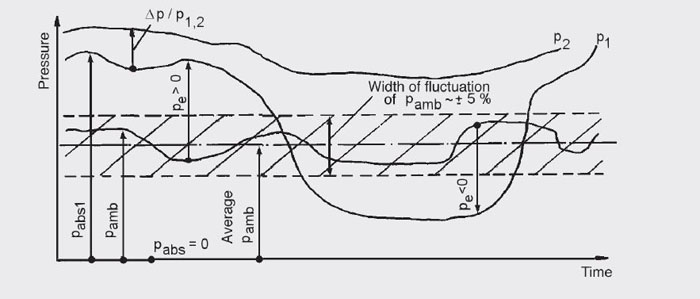Next to temperature, pressure is one of the most important physical state variables. The pressure is defined as a force (FN) which acts uniformly over a defined area (A). The different types of pressure are differentiated only by the reference pressure.
What is absolute pressure?
The clearest reference pressure is the pressure zero, which exists in the air-free space of the universe. A pressure which is related to this reference pressure is known as absolute pressure. For the required differentiation from other types of pressure, it is denoted with the index “abs”, which is derived from the Latin “absolutus”, meaning detached, independent.
What is atmospheric pressure?
The probably most important pressure for life on earth is the atmospheric pressure, pamb (amb = ambiens = ambient). It is created by the weight of the atmosphere which surrounds the earth up to a height of approx. 500 km. Up to this altitude, at which the absolute pressure pabs = zero, its magnitude decreases continuously. Furthermore, the atmospheric pressure is subject to weather-dependent fluctuations, as is only too well known from the daily weather report. At sea level, pamb averages 1,013.25 hectopascal (hpa), corresponding to 1,013.25 millibar (mbar). With “cyclones” and “anticyclones”, this pressure varies by about 5 %.
What is differential pressure?
The difference between two pressures, p1 and p2, is known as the pressure differential, Δp = p1 - p2. In cases where the difference between two pressures itself represents the measured variable, one refers to the differential pressure, p1,2.
What is overpressure (gauge pressure)?
The most frequently measured pressure in the technological field is the atmospheric pressure differential, Pe (e = excedens = exceeding). It is the difference between an absolute pressure, pabs, and the relevant (absolute) atmospheric pressure (pe = pabs - pamb) and is known, in short, as the overpressure or gauge pressure.
A positive overpressure is referred to when the absolute pressure is greater than the atmospheric pressure. In the opposite case, one speaks of negative overpressure.
The indices of the formula symbols “abs”, “amb” and “e” clearly define the reference point of the respective pressure. They are only attached to the formula letter p, and not to the unit symbols.

Whether absolute pressure, gauge pressure or differential pressure. With WIKA, you will find the right measuring instrument for each type of pressure:
Contact us
Would you like further information? Write to us: